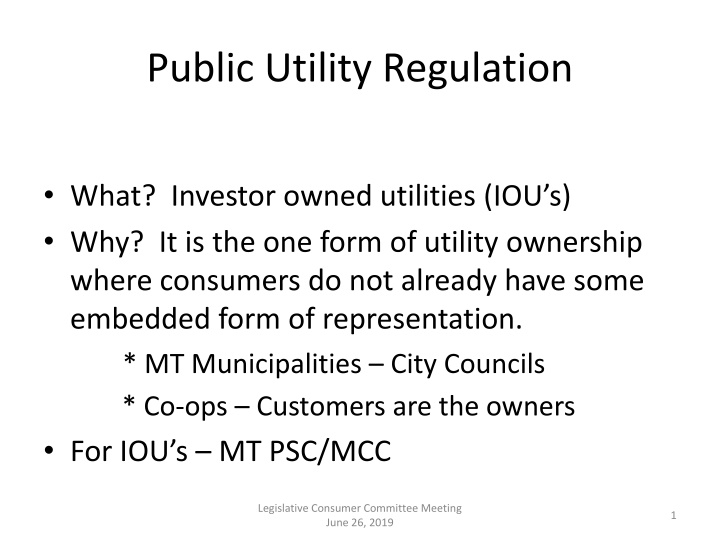
Public Utility Regulation for Investor-Owned Utilities
Learn about the unique characteristics of investor-owned utilities, the purpose of regulation in protecting consumers, and the procedural processes involved in rate setting for utilities. Explore the fundamental role of regulation in acknowledging natural monopolies while safeguarding against abuse of power and ensuring fair pricing and service quality.
Download Presentation

Please find below an Image/Link to download the presentation.
The content on the website is provided AS IS for your information and personal use only. It may not be sold, licensed, or shared on other websites without obtaining consent from the author. If you encounter any issues during the download, it is possible that the publisher has removed the file from their server.
You are allowed to download the files provided on this website for personal or commercial use, subject to the condition that they are used lawfully. All files are the property of their respective owners.
The content on the website is provided AS IS for your information and personal use only. It may not be sold, licensed, or shared on other websites without obtaining consent from the author.
E N D
Presentation Transcript
Public Utility Regulation What? Investor owned utilities (IOU s) Why? It is the one form of utility ownership where consumers do not already have some embedded form of representation. * MT Municipalities City Councils * Co-ops Customers are the owners For IOU s MT PSC/MCC Legislative Consumer Committee Meeting June 26, 2019 1
Fundamentally what is regulation supposed to do? Acknowledge natural monopolies but protect consumers through preventing the abuse of monopoly power high prices, poor service How? Charles F. Phillips, In short, regulation is a substitute for competition and should attempt to put the utility sector under the same restraints competition places on the industrial sector. Charles F. Phillips, The Regulation of Public Utilities: Theory and Practice, (Arlington, VA: Public Utilities Reports, Inc., 1984), p. 154 Legislative Consumer Committee Meeting June 26, 2019 2
Rate Case Procedural Process-Prior to Hearing Utility files application for new rates MCC files to intervene (and other interested parties) Intervenors submit data requests to utility Utility provides data responses MCC/other intervenors file testimony Utility submits data requests to intervenors Intervenors provide data responses Possible additional issues identified by PSC Utility files rebuttal testimony (intervenors may also provide testimony in response to other intervenors) Data requests on rebuttal and cross-intervenor testimony Data responses provided Legislative Consumer Committee Meeting June 26, 2019 3
Procedural Process-Hearing & Forward Hearing held on application Opening briefs filed Answer briefs filed Commission order issued Possible motions for reconsideration Order on reconsideration Possible Judicial review Rules of Evidence and many Rules of Civil Procedure apply. Legislative Consumer Committee Meeting June 26, 2019 4
Utility Rate Setting Process Overview Revenue Requirement (size of the pie) Class Cost Allocation (how to cut the pie) Rate Design (how to collect the pieces of pie) Legislative Consumer Committee Meeting June 26, 2019 5
Revenue Requirement Rev Req = O&M + Taxes + Depreciation + r(Rate Base) Where: O&M Operation and Maintenance Expense Taxes Income and other (i.e. Property taxes) Rate Base Undepreciated value of in-service used and useful utility plant funded by investors in utility Depreciation on in-service, used & useful utility plant r Rate of Return = (Debt cost * % of debt) + (ROE * % of equity); times rate base = utility profit opportunity % of debt and equity used to finance rate base is the Capital Structure Legislative Consumer Committee Meeting June 26, 2019 6
Class Cost of Service Allocation Residential Commercial Industrial How much is to be paid by each class of customer or rate class, based largely on the costs incurred to serve each customer class. Legislative Consumer Committee Meeting June 26, 2019 7
Rate Design Fixed charge customer or service charge Demand charge for level of maximum usage (flow rate) that occurs during a billing cycle Commodity charge for the amount of electricity, water, natural gas that is consumed during a billing cycle Designed to recover each class respective portion of the revenue requirement assuming certain usage levels Legislative Consumer Committee Meeting June 26, 2019 8
PSC Decision The Commission will make decisions on parties various positions leading to final determinations on: Revenue Requirement Class Allocations Rate Design resulting in Tariffed rates Legislative Consumer Committee Meeting June 26, 2019 9
